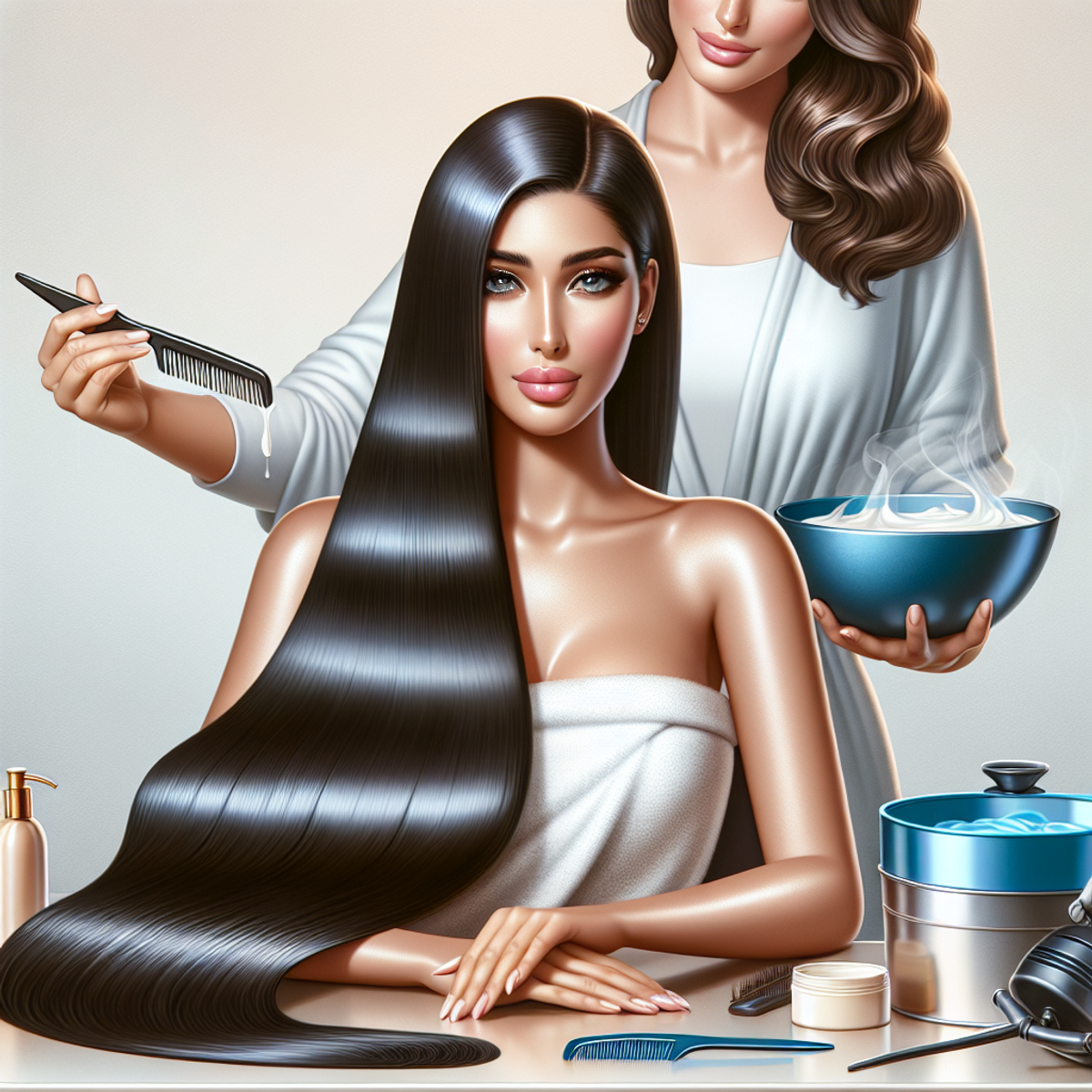How to Deep Condition Your Hair Like a Pro

Introduction
Deep conditioning is an essential hair treatment that plays a crucial role in keeping your hair healthy and beautiful. It involves applying a nourishing conditioner to:
- Add moisture
- Reduce frizz
- Prevent breakage
This process addresses the specific needs of various hair types, making it a versatile solution for everyone.
Why Deep Conditioning Matters
Deep conditioning is more than just a beauty treatment; it’s a vital practice for taking care of your hair’s overall health. By regularly deep conditioning your hair, you can:
- Maintain Healthy Hair: Nourishing your hair with essential moisture helps keep it strong, shiny, and resistant to damage.
- Tame Frizz: Deep conditioning smooths down the hair cuticles, minimizing frizz and flyaways for a sleeker appearance.
- Prevent Breakage: The moisturizing properties of deep conditioners help fortify the hair shaft, reducing the risk of breakage and split ends.
In this article, we’ll explore the world of deep conditioning in detail, providing you with valuable insights and practical techniques to effectively deep condition your hair at home.
1. Why Deep Conditioning is Important
Dryness and damage can have a significant impact on the overall health of your hair. When your hair lacks moisture, it becomes brittle, prone to breakage, and difficult to manage. This is especially true for those with textured hair, such as curly or kinky hair types, which tend to be naturally drier.
Deep conditioning is a crucial step in your hair care routine because it helps restore moisture balance and repair damaged strands. Here’s why deep conditioning is important:
- Moisture Restoration: Deep conditioning treatments are formulated with water-binding and moisturizing ingredients that penetrate the hair shaft to hydrate and nourish your strands from within. These treatments replenish lost moisture, making your hair softer, smoother, and more manageable.
- Repairing Damaged Hair: Chemical processes, heat styling, and environmental factors can cause damage to your hair, leading to split ends, breakage, and frizz. Deep conditioning helps repair this damage by providing essential nutrients and proteins that strengthen the hair shaft, seal the cuticles, and promote healthier growth.
- Textured Hair Care: Textured hair tends to be more susceptible to dryness due to its structure. The natural oils produced by the scalp have a harder time traveling down the twists and turns of curly or kinky strands. Deep conditioning is particularly beneficial for textured hair as it helps retain moisture, reduces frizz, enhances curl definition, and improves overall hair health.
To effectively deep condition your hair at home and reap these benefits, it’s essential to follow the right techniques and use suitable products. In the next section, we will explore the step-by-step process of deep conditioning your hair for optimal results.
Remember that everyone’s hair is unique, so it’s important to listen to your own hair’s needs and adjust your deep conditioning routine accordingly. Experimenting with different products and techniques will help you find what works best for your specific hair type and concerns.
2. The Right Way to Deep Condition Your Hair
When it comes to deep conditioning your hair, the process can make a significant difference in the health and appearance of your locks. Understanding the right way to deep condition will help you achieve optimal results and maximize the benefits for your specific hair type.
Step-by-Step Guide for Optimal Results
To ensure that your hair receives the full benefits of deep conditioning, it’s important to follow a systematic approach:
- Apply to Wet Hair in Sections: Start by thoroughly wetting your hair. This helps open up the hair cuticle, allowing the deep conditioner to penetrate more effectively. Divide your hair into sections to ensure even coverage and distribution of the product.
- Enhance Penetration with a Plastic Cap or Wrap: After applying the deep conditioner, covering your hair with a plastic cap or wrap creates a controlled environment that traps heat and encourages deeper penetration of the product into the hair shaft. This step is crucial for maximizing the moisturizing and reparative effects of the deep conditioner.
Expert Tips for Detangling
Detangling your hair during the deep conditioning process is essential for preventing further damage or breakage. Here are some expert tips to consider:
- Use a wide-tooth comb or your fingers to gently detangle your hair while the deep conditioner is applied.
- Start detangling from the ends and work your way up towards the roots to minimize tugging and potential damage.
- Be patient and gentle, especially if you have textured or tightly coiled hair, as these hair types are more prone to tangling.
The Role of Heat and Different Heat Sources
The application of heat can significantly enhance the effectiveness of deep conditioning by opening up the hair cuticle further, allowing better absorption of the product. Consider these options for applying heat:
- Steamer: Using a steamer is an excellent way to deliver indirect heat to your hair, aiding in product absorption without direct contact.
- Warm Towel Wrap: Wrapping a warm towel around your head after applying the deep conditioner can create a similar effect by generating heat within a confined space.
Benefits of Rinsing with Cold Water
After allowing the deep conditioner to work its magic, rinsing with cold water provides several benefits:
- Sealing Cuticles: Cold water helps seal the cuticle layer of the hair, resulting in smoother strands and enhanced shine.
- Locking in Moisture: By closing the cuticle, cold water helps lock in moisture from the deep conditioning treatment, prolonging its effects until your next wash.
By following these steps and expert tips, you can ensure that your deep conditioning routine is optimized for maximum effectiveness and benefits for your hair.
3. Choosing the Right Deep Conditioner for Your Hair Needs
When it comes to deep conditioning, selecting the right product for your hair needs is crucial. Understanding the different types of ingredients found in deep conditioners and how they work can help you make an informed choice. Here are some key points to consider:
Humectants and Emollients
Deep conditioners often contain these two types of ingredients that work together to hydrate and nourish the hair.
- Humectants like glycerin, honey, and aloe vera attract moisture from the environment and help retain it in your hair. They are especially beneficial for dry or dehydrated hair.
- Emollients such as olive oil, shea butter, and coconut oil help soften the hair, improve elasticity, and seal in moisture. They are excellent choices for damaged or brittle hair.
Hair Concerns
Different deep conditioning treatments target specific hair concerns. Here are some examples:
- Dryness: Look for deep conditioners that provide intense hydration and moisture retention properties. Ingredients like hyaluronic acid, panthenol (provitamin B5), and ceramides can help replenish dry hair.
- Damage: If your hair is damaged from heat styling, chemical treatments, or environmental factors, opt for deep conditioners with protein-rich ingredients like hydrolyzed keratin or wheat protein. These ingredients help strengthen the hair shaft and minimize breakage.
- Frizz Control: To tame frizz and promote smoothness, choose deep conditioners that contain natural oils such as argan oil or jojoba oil. These oils help to moisturize the hair and create a protective barrier against humidity.
Hair Type
Consider your specific hair type when selecting a deep conditioner:
- Curly Hair: Curly hair tends to be more prone to dryness and requires extra moisture. Look for deep conditioners that are specifically formulated to enhance curl definition and provide long-lasting hydration. Ingredients like shea butter, avocado oil, and coconut milk can work wonders for curly hair.
- Fine Hair: Fine hair can easily be weighed down by heavy deep conditioners. Opt for lightweight formulas that provide moisture without leaving a greasy residue. Deep conditioning once or twice a month is usually sufficient for fine hair.
- Color-Treated Hair: If you have color-treated hair, choose deep conditioners that are free from sulfates and harsh chemicals. Look for products that contain ingredients like argan oil, which help to maintain color vibrancy while nourishing the hair.
Remember, finding the right deep conditioner may involve some trial and error. Pay attention to how your hair responds to different products and adjust your routine accordingly. Don’t hesitate to seek recommendations from professionals or fellow hair enthusiasts who have similar hair types or concerns.
4. Enhancing Deep Conditioning Results with Additional Treatments
When it comes to deep conditioning your hair, there are additional treatments you can incorporate into your routine to enhance the results and give your hair some extra TLC. These treatments work together with deep conditioning to provide even more nourishment, strength, and moisture to your locks. Here are a few options to consider:
4.1 Protein Treatments for Stronger Strands
Protein treatments are a great addition to your deep conditioning routine, especially if you have damaged or weak hair. These treatments contain hydrolyzed proteins that go inside the hair shaft, fixing and strengthening it from within. Protein treatments help bring back elasticity, reduce breakage, and improve overall hair health. Here’s how you can incorporate protein treatments into your routine:
- Frequency: Protein treatments should be used sparingly, about once every 4-6 weeks or as needed. Using protein treatments too often can lead to protein overload and make your hair feel stiff and brittle.
- Timing: Apply the protein treatment after deep conditioning and leave it on for the recommended time specified on the product label.
- Follow-up: After rinsing out the protein treatment, follow up with a moisturizing conditioner to restore moisture balance.
4.2 Hot Oil Massages for Intensive Hydration
Hot oil massages are a luxurious treatment that provides intense hydration to your hair and scalp. The heat helps open up the cuticles, allowing the oil to go deep inside and moisturize your strands. Here’s how you can incorporate hot oil massages into your routine:
- Oil Selection: Choose an oil that suits your hair needs. Some popular options include coconut oil, olive oil, argan oil, or jojoba oil.
- Heating the Oil: Warm the oil by placing the container in a bowl of hot water or microwaving it for a few seconds until it reaches a comfortable temperature.
- Application: Apply the warm oil to your scalp and hair, massaging gently with your fingertips. Cover your hair with a shower cap or towel to trap heat and leave the oil on for 30 minutes to an hour.
- Rinsing: After the designated time, rinse out the oil thoroughly using warm water and follow up with your regular shampoo and conditioner routine.
4.3 Steam Therapy for Deep Penetration
Steam therapy is a great way to enhance the effectiveness of deep conditioning treatments. The steam helps lift the hair cuticles, allowing the deep conditioner to go deeper into the strands. Here’s how you can incorporate steam therapy into your routine:
- Steamer: Invest in a hair steamer or use a DIY method by placing a towel soaked in warm water over your shower cap.
- Duration: Steam your hair for about 15-20 minutes while deep conditioning. Make sure that the steam is comfortably warm, not too hot, to avoid damaging your scalp or hair.
- Benefits: The steam helps open up the hair cuticles, allowing for better absorption of moisture and nutrients from the deep conditioner.
Remember, these additional treatments are meant to complement your regular deep conditioning routine. Try out different options to find what
Deep Conditioning Tips for Different Hair Types
5.1 Deep Conditioning Fine Hair: Dos and Don’ts
Fine hair requires special care when it comes to deep conditioning. Here are some essential dos and don’ts to keep in mind:
Dos:
- Use Lightweight Formulas: Opt for deep conditioners that are specifically formulated for fine hair. Look for products labeled as “lightweight” or “volumizing” to avoid weighing down your strands.
- Focus on the Ends: Concentrate the deep conditioner on the mid-lengths and ends of your hair, where moisture is needed most. Avoid applying it directly to the roots, as this can make fine hair appear greasy.
- Limit Frequency: Deep condition fine hair once a week or every other week to prevent product buildup and maintain a balanced level of hydration.
Don’ts:
- Overuse Heavy Formulas: Avoid using deep conditioners that are rich and heavy, as they can make fine hair look limp and flat.
- Apply Excessive Product: Using too much deep conditioner can overload fine hair, making it appear greasy and difficult to style.
By following these dos and don’ts, you can effectively deep condition fine hair without compromising its natural volume and texture. For more information on hair care, you might find these articles on glycerin usage for curly hair and protein-moisture balance helpful as well.
5.2 Nurturing Curly Hair with the Right Deep Conditioning Routine
Curly hair has its own unique needs when it comes to moisture and hydration. The natural shape of curly hair makes it more prone to dryness and frizz due to the difficulty for natural oils to travel down the hair shaft. To keep your curls healthy and defined, it’s important to have a deep conditioning routine that caters specifically to your curly hair needs. Here are some tips to help you nurture your curls with the right deep conditioning routine:
- Choose a deep conditioner that defines and enhances curl pattern: Look for a deep conditioner that is specifically formulated for curly hair. These conditioners often contain ingredients like shea butter, coconut oil, and argan oil, which help to moisturize and nourish your curls. They also usually have properties that enhance curl definition, reduce frizz, and promote bounce.
- Apply the deep conditioner generously: Curly hair tends to be more porous, meaning it absorbs products more easily. To ensure that your curls receive enough moisture, apply the deep conditioner generously from roots to ends. Be sure to focus on areas that tend to be drier, such as the ends of your hair.
- Detangle gently: Detangling curly hair can be a delicate process, as it is prone to tangling and breakage. Before applying the deep conditioner, gently detangle your curls using a wide-tooth comb or your fingers. Start from the ends and work your way up to avoid causing unnecessary damage.
- Use a plastic cap or wrap: To enhance the effectiveness of the deep conditioner, cover your hair with a plastic cap or wrap after applying the product. This creates a warm environment that allows the conditioner to penetrate deeply into your curls.
- Add heat if desired: While heat is not necessary for deep conditioning curly hair, some people find that it helps the product to penetrate even further. If you choose to use heat, be sure to use a low or medium setting and avoid excessive heat that can cause damage. You can use a hooded dryer, a steamer, or simply wrap your hair in a warm towel.
- Rinse with cold water: After the deep conditioning process, rinse your hair with cold water. This helps to seal the cuticles and lock in moisture, resulting in shinier and smoother curls. Cold water also has the added benefit of reducing frizz.
Remember, every curly head is unique, so it may take some trial and error to find the perfect deep conditioning routine for your specific curls. Pay attention to how your hair responds to different products and adjust your routine accordingly. With consistent deep conditioning tailored to your curly hair needs, you can enjoy healthy, bouncy, and defined curls that turn heads wherever you go.
5.3 Deep Conditioning Natural Hair: Essential Care Practices
Regular deep conditioning is extremely important for taking care of natural hair. Natural hair tends to be dry and fragile, which makes deep conditioning a critical step in keeping it healthy and strong. Here are some essential care practices for deep conditioning natural hair:
1. Be Consistent
Make deep conditioning a regular part of your curly hair care routine. Depending on your hair’s porosity and texture, aim to deep condition at least once a week or as needed to keep your strands well-nourished and moisturized.
2. Try DIY Recipes
Harness the power of natural ingredients by making your own deep conditioning treatments at home. Ingredients like avocado, banana, honey, coconut milk, and olive oil can do wonders for natural hair. For example, you can create a simple DIY recipe by mashing a ripe avocado with a tablespoon of honey and applying it to freshly washed hair. Leave the mixture on for 30 minutes before rinsing with cold water to enjoy soft, nourished locks.
3. Choose Tailored Treatments
Take into account the specific needs of your natural hair when selecting or making deep conditioning treatments. Look for ingredients that offer intense hydration and nourishment, such as shea butter, argan oil, and aloe vera. These natural moisturizers can help replenish moisture and strengthen your hair from the inside out.
In addition to these essential care practices, there are other techniques you can incorporate into your routine to further enhance your natural hair care regimen. For instance, using heat effectively during deep conditioning is crucial. You may want to explore the benefits of using heat in conjunction with deep conditioning, as it can help open up the hair cuticles and allow the conditioner to penetrate more effectively.
Furthermore, it’s worth noting that saunas can be beneficial for natural hair as well. The heat and steam from a sauna session can help to open up the hair cuticles, allowing deep conditioning treatments to penetrate more deeply. So, if you have access to a sauna, consider incorporating it into your hair care routine for added benefits. To learn more about how to get the most out of a sauna for your hair, check out this helpful guide: How to Get the Most Out of a Sauna for Your Hair.
By incorporating these essential care practices into your natural hair routine, you’ll be able to achieve healthier and more resilient locks that radiate natural beauty.
Deep Conditioning Precautions and Common Mistakes to Avoid
Potential Risks of Overdoing Deep Conditioning Treatments
When it comes to deep conditioning, more is not always better. Over-conditioning can lead to hair feeling limp, looking greasy, or even becoming more prone to breakage. It’s essential to strike a balance and avoid overwhelming your hair with too much moisture.
Signs of Product Buildup and Prevention Tips
Product buildup occurs when styling products, oils, or deep conditioners accumulate on the hair and scalp, leading to dullness, weighed-down strands, or even scalp issues. Watch out for these common signs of product buildup:
- Lack of Volume: If your hair feels flat and lifeless despite washing and styling, it could be a sign of product buildup.
- Residue on Strands: Run your fingers through your hair – if you feel a sticky or waxy residue, it’s likely product buildup.
- Itchy Scalp: Buildup can clog the hair follicles and lead to scalp irritation or itchiness.
To prevent product buildup when using rich deep conditioners:
- Clarifying Shampoo: Regularly incorporate a clarifying shampoo into your routine to remove any accumulated residue.
- Proper Rinsing: Ensure thorough rinsing of the deep conditioner from your hair to minimize leftover product.
- Balanced Application: Use the right amount of deep conditioner for your hair type and length to avoid excessive buildup.
Remember that maintaining a healthy balance in your deep conditioning routine is key to reaping its benefits without experiencing unwanted side effects.
Conclusion
Deep conditioning is an essential step in maintaining a healthy hair care routine. It plays a vital role in restoring moisture, repairing damage, and preventing breakage. By incorporating deep conditioning into your regular hair care regimen, you can enjoy the following benefits:
- Moisture balance: Deep conditioning helps replenish moisture to dry and dehydrated hair, keeping it soft, smooth, and manageable.
- Damage repair: The nourishing ingredients in deep conditioners work to repair damaged strands, improving the overall health and appearance of your hair.
- Frizz control: Deep conditioning reduces frizz by sealing the hair cuticles and providing essential hydration to keep your hair smooth and sleek.
- Prevention of breakage: Regular deep conditioning strengthens the hair shaft, making it less prone to breakage and split ends.
Investing time and effort into deep conditioning is worthwhile because it can transform the condition of your hair. By following the proper deep conditioning techniques and choosing the right products for your specific needs, you can achieve optimal results. Remember these key points:
- Apply deep conditioner to wet hair in sections for even distribution.
- Use a plastic cap or wrap to enhance penetration and improve product absorption.
- Detangle your hair gently during the deep conditioning process to avoid further damage or breakage.
- Consider incorporating heat sources like a steamer or warm towel wrap for deeper penetration of the product.
- Rinse with cold water after deep conditioning to seal the cuticles and enhance shine.
By understanding why deep conditioning is important, choosing the right products for your hair type, and enhancing your routine with additional treatments like protein treatments or hot oil massages, you can take your deep conditioning game to the next level.
So go ahead and give your locks some extra love by embracing the power of deep conditioning. Your hair will thank you for it!










